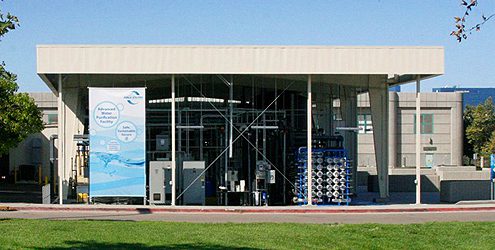 The San Diego County Water Authority unveiled a renovated demonstration garden at its Kearny Mesa headquarters designed to inspire more residents to create outdoor spaces that achieve multiple environmental benefits.
The San Diego County Water Authority unveiled a renovated demonstration garden at its Kearny Mesa headquarters designed to inspire more residents to create outdoor spaces that achieve multiple environmental benefits.

The approximately 3,000-square-foot garden provides a tangible example of the recommendations of the San Diego Sustainable Landscapes Program, or SLP, and highlights four key principles of sustainable landscaping.
Here’s what to look for when visiting the garden:
- Healthy, Living Soils: Healthy, living soils rich in organic content feed a complex soil food web. The soil holds water like a sponge and has nutrients for better plant health. Healthy soil may also play an important role in carbon sequestration. The garden has a 1.3 in layer of compost mixed into the soil and is topped with 3 inches of mulch to suppress weeds and reduce evaporation.
- Climate-Appropriate Plants: A large selection of beautiful groundcovers, shrubs and trees is compatible with San Diego’s mild Mediterranean climate. These plants use less water and exhibit diverse colors, textures and shapes, while providing endless design opportunities. The garden uses more than 20 varieties of very low to moderate water-use plants, placed in hydrozones where plants with similar irrigation needs are grouped together.
- High-Efficiency Irrigation: A smart irrigation controller adjusts water automatically in response to site and changing weather conditions. High-performance distribution components regulate pressure and are tailored to fit the exact watering needs of different plants in the landscape. The garden has inline drip irrigation and rotating nozzles to maximize water-use efficiency.
- Rainwater as a Resource: Sustainable landscapes make the most of rainfall onsite. By slowing its flow, water is captured from rooftops and other hard surfaces so it can sink into the soil or be stored for later use. The garden demonstrates rainwater harvesting through a bioswale and detention basin next to the building and rain barrels along the entryway.

The garden also features an exhibit-quality sign to introduce visitors to key sustainable landscaping principles. The sign includes a QR Code that enables visitors to use their smartphones to quickly locate related SLP resources at sustainablelandscapessd.org.
Smaller signs throughout the landscape identify specific plant types. Free brochures on sustainable landscaping featuring the landscape’s design plan and plant palette are also available for visitors to take home.

To learn more about water conservation incentives, programs, resources and more, go to watersmartsd.org or follow SDCWA on Facebook, Twitter and Instagram.





 Limit outdoor watering to two days per week, less if you can.
Limit outdoor watering to two days per week, less if you can.









